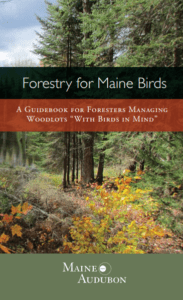 The Forestry for Maine Birds Guidebook (pdf) will provide foresters and landowners with background about the program, details on specific species we are targeting for conservation, desired habitat conditions, and silvicultural recommendations to achieve those habitat conditions.
The Forestry for Maine Birds Guidebook (pdf) will provide foresters and landowners with background about the program, details on specific species we are targeting for conservation, desired habitat conditions, and silvicultural recommendations to achieve those habitat conditions.
Below we have pulled out and created PDFs of pages from the Forester’s Guidebook that may be helpful to share with landowners or include as attachments in a completed forest management plan.
20 Species of Conservation Priority Information Sheets
- American Woodcock
- Bay-breasted Warbler
- Blackburnian Warbler
- Black-backed Woodpecker
- Black-throated Blue Warbler
- Black-throated Green Warbler
- Boreal Chickadee
- Canada Warbler
- Chestnut-sided Warbler
- Eastern Wood-PeeWee
- Magnolia Warbler
- Mourning Warbler
- Northern Flicker
- Northern Parula
- Olive-sided Flycatcher
- Ovenbird
- Scarlet Tanager
- Veery
- Wood Thrush
- Yellow-bellied Sapsucker
Four Forest Habitat Type Descriptions
FFMB Forester’s Guide Forms and Tables
- Stand Structure Class
- Assessment Data Form for Stands
- Forest Habitat Association Table
- Landscape Context Assessment
- Property Summary
- Stand Assessment Data Form
For help working with loggers on ensuring their operations are also done “with birds and other wildlife in mind” please refer to The Logger’s Guide to Forestry for Maine Birds (available here as a PDF) or email conserve@maineaudubon.org to request printed copies.
Here you may find a template for completing the biodiversity section of an NRCS CAP plan that incorporates fish- and wildlife-friendly habitat features into a management plan. This template can also be incorporated into a Maine Forest Service Be Woods Wise stewardship or management plan. And here is a presentation on instructions for contracting CAP plans.
And here is a crosswalk of desired habitat features and specific NRCS practices that can be used to
enhance or create those features.
